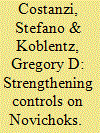|
|
|
Sort Order |
|
|
|
Items / Page
|
|
|
|
|
|
|
| Srl | Item |
| 1 |
ID:
171181


|
|
|
|
|
| Summary/Abstract |
Novichok agents are a class of nerve agents developed by the Soviet Union during the Cold War. In light of the use of a Novichok agent in Salisbury in March 2018, two sets of proposals to amend Schedule 1 of the 1993 Chemical Weapons Convention (CWC) have been put forth, one jointly by the United States, Canada, and the Netherlands, and the other by Russia. Both sets of proposals will be discussed and voted upon at the next Conference of States Parties of the Organisation for the Prohibition of Chemical Weapons (OPCW) in November 2019. If either set of proposals is approved, it will be the first time that the list of chemicals subject to verification under the CWC will have been modified. This viewpoint will discuss these proposals, and argue that, if adopted, the joint proposal and the portions of the Russian proposal upon which consensus can be reached would significantly strengthen the CWC by considerably expanding the coverage of its Schedule 1 and bringing Novichok agents firmly within the CWC’s verification system. We also argue that, since the OPCW Technical Secretariat did not deem the fifth group of chemicals proposed by Russia to meet the criteria for inclusion in Schedule 1, Russia should withdraw this part of its proposal from consideration. The proposals have also served an important purpose in clarifying the identity of the chemical agent used in the Salisbury incident, squarely placing it within one of the two families of Novichok agents described by the Russian chemical-weapons scientist and whistleblower Vil Mirzayanov. If either proposal is approved in November, it will be important to conduct a thorough assessment of key precursors for the synthesis of Novichok agents and assess the need to amend CWC schedules and national and multinational export-control lists accordingly.
|
|
|
|
|
|
|
|
|
|
|
|
|
|
|
|
| 2 |
ID:
187492


|
|
|
|
|
| Summary/Abstract |
Novichoks, also known as A-series agents, are nerve agents developed in the Soviet Union during the Cold War. Once obscure chemicals, they garnered a great deal of attention after their employment in the attempted assassinations of Sergei and Yulia Skripal in 2018 and of Alexei Navalny in 2020. Novichok agents were not originally featured in the schedules of the Chemical Weapons Convention (CWC), which are intended to support the treaty’s verification regime and declaration requirements. However, following the Skripal incident, the CWC schedules were amended to include Novichok agents. Furthermore, precursors for their synthesis were added to the Australia Group’s (AG) list of chemical-weapons precursors. In this article, we evaluate the recent revisions of the CWC schedules and the AG precursors list, identify the remaining weaknesses of both lists, and make recommendations for further amendments. We recommend strengthening the coverage of the CWC schedules by adding families of Novichok agents with guanidine branches. This is particularly important in light of the Navalny incident, since that incident appears to have involved a guanidine-bearing Novichok agent currently not covered by the CWC schedules. We also propose an approach to the control of Novichok precursors by the CWC and the AG based on families of chemicals rather than individually enumerated chemicals.
|
|
|
|
|
|
|
|
|
|
|
|
|
|
|
|
| 3 |
ID:
173012


|
|
|
|
|
| Summary/Abstract |
In late June 2018, Charlie Rowley and Dawn Sturgess, residents of Amesbury in the United Kingdom, discovered a discarded perfume bottle. Just 15 minutes after Sturgess sprayed her wrists to test the scent at home, she became ill and, nine days later, became the only fatality from a chemical weapons agent used in the UK. Rowley, exposed to a lesser degree, survived after multiple hospitalizations.
|
|
|
|
|
|
|
|
|
|
|
|
|
|
|
|
|
|
|
|
|